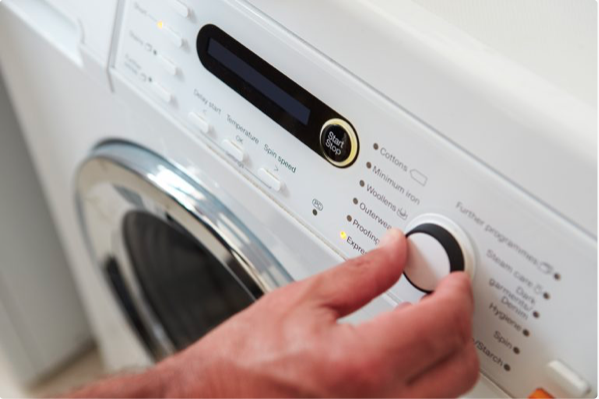Descale the washing machine – so that the machine will run for years
Have you ever been annoyed because the new washing machine broke after a few years? Lime is often to blame for defective machines. How quickly deposits form depends on the hardness of the water together. Soft water is ideal for washing. If medium-hard or hard water comes out of the pipes in your home, you must be prepared for problems with calcification.
Descaling extends the life of the washing machine
The washing machine washes constantly. That is why many believe in some kind of automatic self-cleaning. However, detergent residues, hair or dirt accumulate and must be cleaned away regularly. Limescale deposits are usually less visible. They can be noticed by white stains on the laundry or in the drum. However, the fastest parts of the machine that you normally cannot see are usually calcified.
The heating rod in the washing machine is most susceptible to limescale. Lime has the property of primarily settling where water is heated. With every heating, a little lime is deposited on the heating element. If you have your kettle If you use it regularly, you can observe how a layer of lime also settles here. The deposits on the heating element of the washing machine grow just as quickly or slowly – provided, of course, that you also fill the kettle with tap water.
The problem with calcified heating rods is that they can no longer transfer the heat directly to the water. On the one hand, this increases energy consumption – you need more electricity to bring the washing machine to operating temperature. On the other hand, the heating element can be broken. If he can no longer give off the heat, he himself will get hotter and overheated at some point. A new heating element is needed.
Descaling the washing machine – what you should keep in mind
As a rule of thumb, the washing machine should be descaled twice a year. With soft water, once a year is probably enough; with hard water, limescale should be removed from the machine every few months. If the power consumption increases or the washing machine no longer heats properly, these are signs of a very calcified heating element. You may be able to save the device with intensive descaling.
Regular descaling makes sense even with soft water. Even small amounts of limescale deposits on the heating rod increase power consumption. Descaling is cheap and quick. This will save you heating or repair costs in any case.
For fear of limescale deposits, many consumers turn to water softeners for the washing machine. Such softeners can delay the calcification of the machine, but do not stop them. Most commercial detergents, however, already contain softening substances. With hard water, you can either use a higher dose of detergent according to the manufacturer’s instructions or use a water softener and only use the amount of detergent for soft water.
This is how descaling the washing machine works
Before you descale the washing machine, you need to decide on a suitable descaler. Washing machine cleaners are available in stores that also descale. If you only want to descale, agents are also sold for this.
But home remedies are just as effective. The advantage is that they are usually cheaper and you may already have them at home. Acetic acid or citric acid are often used to descale the washing machine. But be careful – the use of home remedies is always at your own risk. Some washing machine manufacturers state that they can attack sensitive rubber seals. In the worst case scenario, if there is any real damage, the guarantee may expire. One way to cover yourself is to simply ask. Call customer service and find out about using home remedies to descale your washing machine.
To descale, simply run a wash cycle without laundry. As a rule, the cooking program is selected for this, i.e. at 90 or 95 degrees Celsius. It is different when using citric acid. If you heat it, it can combine with the deposited lime and form even harder deposits. You probably can’t get rid of them at all. Therefore, when descaling with citric acid, the cold program should be selected. Play it safe when the temperature is below 40 degrees Celsius.
Simply put the selected descaler in the dispenser and start the program. A good tip is to interrupt the program for about 30 minutes in between. This allows the descaling solution to take effect.
Prevent limescale – reduce deposits
Descaling the washing machine is not difficult. With hard water, however, constant descaling takes away your nerves and time. A simple way to prevent limescale build-up is to use the right amount of detergent. To do this, you should know your water hardness level. You can achieve a similar effect by adding a water softener. However, a softener is not a descaler. So with such a means you cannot remove existing calcifications.
If your hard water bothers you in other areas of the household, you should purchase a water softener worth considering. This is how you get soft water. It is also possible to set up a service water system for your house. Such systems are mostly used to collect rainwater that can be used for irrigation, toilet flushing and washing machines. Rainwater has a hardness level of almost zero. In any case, you should be careful with this: Water that is so soft can quickly attack pipes and metal parts because it is slightly acidic.
Even with these means and methods, you will not be able to completely avoid descaling. With a washing machine that is regularly descaled, you will definitely enjoy it longer.



